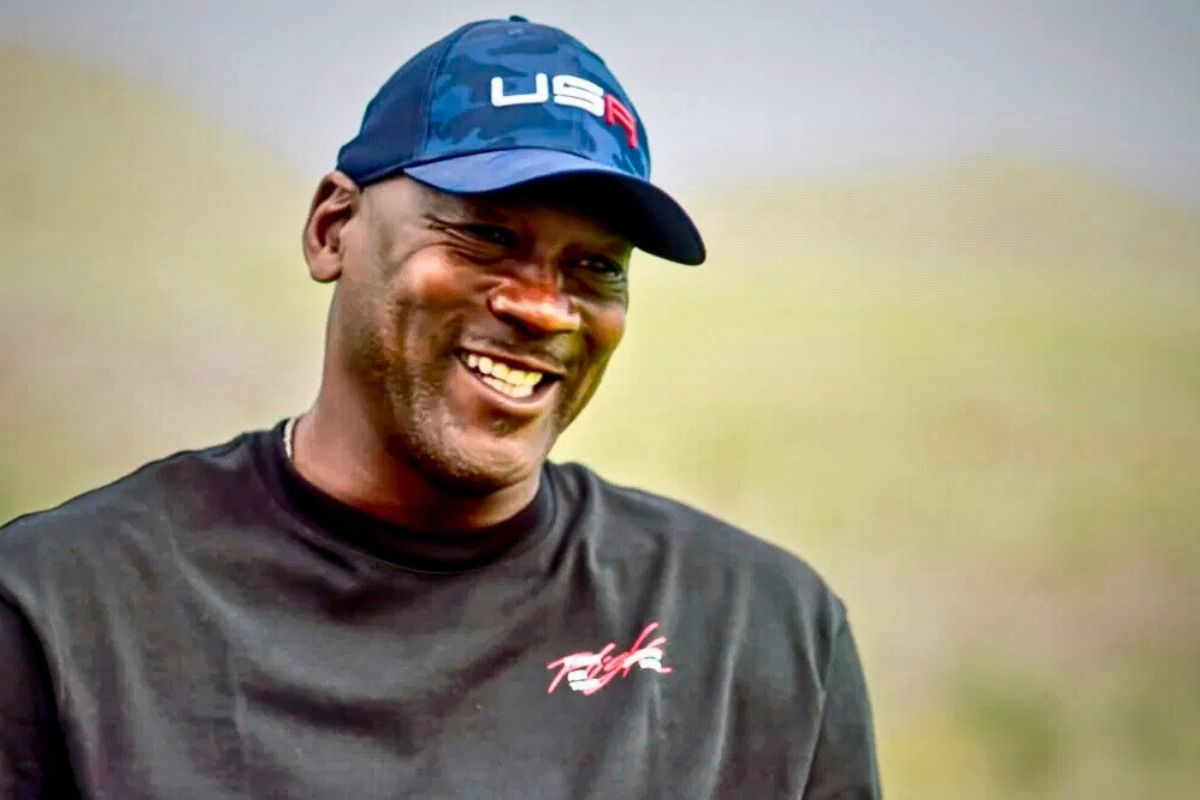
Imago
September 27, 2021 – Kohler, Wisconsin, USA. – Basketball greats MICHAEL JORDAN and Steph Curry sit down at Whistling Straits, site of the Ryder Cup, to talk golf. Kohler U.S. – ZUMAce6_ 20210927_zaf_ce6_005 Copyright: xNbcxGolfx

Imago
September 27, 2021 – Kohler, Wisconsin, USA. – Basketball greats MICHAEL JORDAN and Steph Curry sit down at Whistling Straits, site of the Ryder Cup, to talk golf. Kohler U.S. – ZUMAce6_ 20210927_zaf_ce6_005 Copyright: xNbcxGolfx
“Just last week in Queens, New York, more than 200 people lined up to pay $200 for a shoe, most of them already own,” CBS Sunday Morning reported. That’s the kind of pull the Air Jordan still has. And to think, back in the mid-80s, Nike wasn’t even the top dog. Adidas was pulling in 50% more in revenue, Reebok was exploding onto the scene, and Converse had a chokehold on the NBA with names like Magic Johnson, Larry Bird, and Dr. J repping their kicks. Nike? An underdog in need of a breakout.
Watch What’s Trending Now!
But then came a game-changer. Literally. When Nike dropped the first Air Jordan—the bold black and red ones—for $65 back in 1985, it shook the entire sneaker industry. Fast forward to now, and those same kicks are easily the most successful basketball shoes in history. Sneakerheads still camp out overnight, swipe their cards without blinking, and treasure them like family heirlooms. But here’s the kicker: the whole thing nearly never happened.
Back in 1984, Michael Jordan was just a college star with NBA potential—not the legend we know today. And according to Nike veteran Howard White, Jordan didn’t even want to meet with the company. “He didn’t wanna come,” White recalled. It was only thanks to his parents, Deloris and James, that he ended up at Nike’s Beaverton HQ. The meeting? High stakes. At the time, Nike was still finding its footing in the basketball world.
ADVERTISEMENT
What happened next? A bold swing. “This was bigger than anything that we’d done,” White told CBS Sunday Morning, rocking a pair of Dior Jordans—yeah, the ones that retail for up to $17,000. “Typically, a great player would get like a hundred thousand dollars. But this was so unique… just having the guts to make something like this happen.”
And guts it was. Nike offered Jordan $2.5 million—triple what any other NBA player was getting. It was a massive gamble. But MJ signed the deal. Nike hoped to make $3 million in four years. Instead, they made $126 million in year one. Now, as Nike celebrates 40 years of Jordan, it’s clear: the brand wasn’t just about MJ. He was the brand all along.
ADVERTISEMENT
Michael Jordan’s still calling shots at the brand he built
Even after four decades, Nike hasn’t just kept Michael Jordan around for the legacy points—they’ve made sure he stays front and center. Since their first handshake deal in 1984, the sportswear giant has paid MJ an estimated $1.3 billion in royalties, according to Forbes. And those payments reflect more than simple endorsement fees. In 2024, Jordan Brand generated approximately $7 billion in revenue for Nike, representing roughly 7 percent of Nike’s total sales that year, and funneled between $150 million and $256 million directly to Jordan under his contract

Getty
PARIS, FRANCE – JUNE 12: In this handout image provided by Jordan Brand, Michael Jordan paid a visit to Palais 23 this afternoon on Friday June 12, Joined by his frequent partners-in-design Tinker Hatfield and Mark Smith, key figures in the 30-year evolution of the Air Jordan, Jordan has returned to Paris to mark the 30th anniversary of 1985’s Air Jordan One. Palais 23 is a spectacular tribute to the shoes, moments, designs and artifacts that have shaped the 30-year evolution of the Air Jordan. (Photo by Jordan Brand via Getty Images)
But the real kicker? That investment helped turn Nike from a scrappy underdog into a global force. Jordan didn’t just wear the Swoosh—he made it cool.
ADVERTISEMENT
Still, there’s more to the brand than just sneakers and stats. As Jason Mayden, the Jordan Brand’s chief design officer, explained to CBS Sunday Morning, “In order to translate what he did as a man into what we do as a brand, you have to start with the series of principles we call them ethos.” And those principles aren’t just buzzwords—they’re a blueprint.
In fact, Mayden broke it down further, saying, “So you first start with connectivity… Then you put that into a very strict process that we call visionary.” While the actual playbook remains behind closed doors, the numbers tell the story. The Jordan Brand now brings in around $7 billion each year for Nike. And yes, the “Jordan 40” is already in the works—top secret, of course.
ADVERTISEMENT
Jordan Brand’s cultural pull underscores this dynamic. Worldwide, the Jumpman logo appears not only on court but in fashion runways, music videos, and collabs—from Off‑White’s Virgil Abloh to Dior’s $17,000 renditions—reflecting MJ’s continued influence on creative culture.
Even now, Mayden says MJ is fully hands-on. “He’s very integral to the operation. He sees everything… He has opinions on things that are near and dear to him.” So yeah, Jordan’s not just cashing checks—he’s still crafting his legacy.
ADVERTISEMENT
ADVERTISEMENT
ADVERTISEMENT

